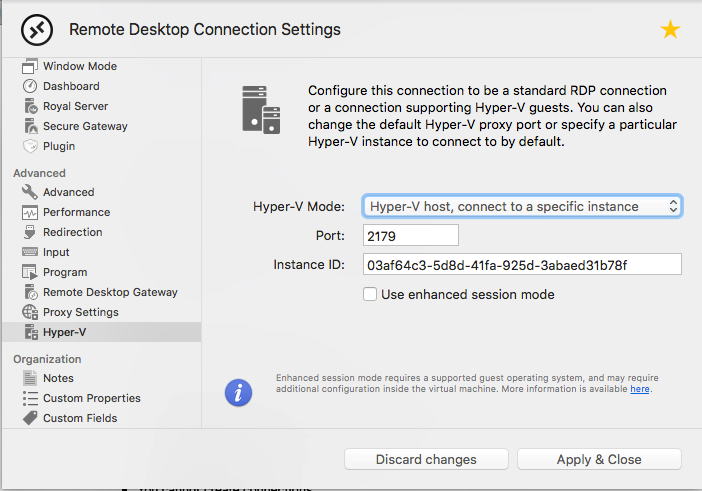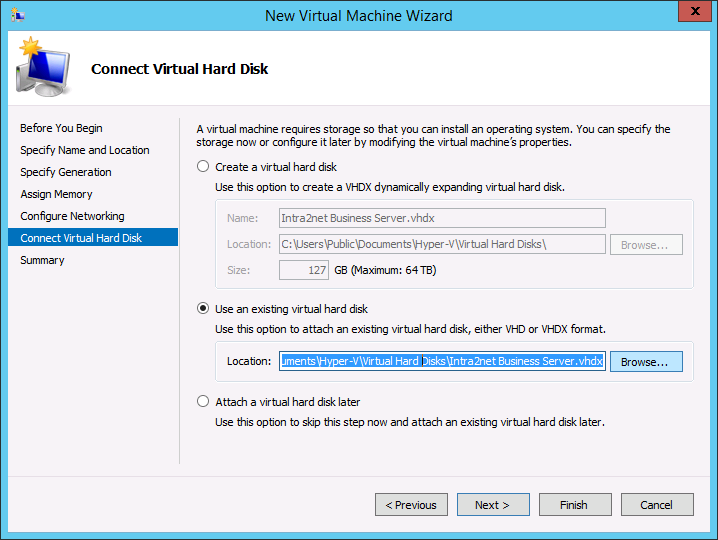
- #Hyperv os x vm how to
- #Hyperv os x vm install
- #Hyperv os x vm upgrade
- #Hyperv os x vm windows 10
- #Hyperv os x vm software
On the Create Virtual Switches page, Virtual Machine Migration page, and Default Stores page, select the appropriate options. To add the tools that you use to create and manage virtual machines, click Add Features. On the Select server roles page, select Hyper-V. On the Select destination server page, select a server from the server pool and then click Next. On the Select installation type page, select Role-based or feature-based installation and then click Next. On the Before you begin page, verify that your destination server and network environment are prepared for the role and feature you want to install. In Server Manager, on the Manage menu, click Add Roles and Features.
#Hyperv os x vm install
Install the Hyper-V role by using Server Manager You can install the Hyper-V role in Server Manager or by using Windows PowerShell. To enable Client Hyper-V on Windows 8 or Windows 8.1 To install the Hyper-V role in Windows Server 2012 or Windows Server 2012 R2 Install Hyper-V so you can create and run virtual machines on this computer.
#Hyperv os x vm software
Software to install as the guest operating system for the virtual machine.
#Hyperv os x vm upgrade
Step 4: Install or upgrade integration servicesīefore you install Hyper-V, make sure that you have the following:Ī user account with administrator permissions for the computer.Įnough memory to run all the virtual machines that you plan to run at the same time. Step 3: Install the guest operating system
#Hyperv os x vm windows 10
For the most current version of this topic, see Install Hyper-V on Windows 10 or Install the Hyper-V role on Windows Server 2016. To learn more about Hyper-V including system requirements, see Hyper-V overview.
#Hyperv os x vm how to
Learn how to get started with Hyper-V on Windows Server 2012, Windows Server 2012 R2, Windows 8, or Windows 8.1 Professional and Enterprise editions. Issues found in Microsoft operating systems and in integration services are supported by Microsoft support.įor issues found in other operating systems that have been certified by the operating system vendor to run on Hyper-V, support is provided by the vendor.įor issues found in other operating systems, Microsoft submits the issue to the multi-vendor support community, TSANet.Applies To: Windows 8, Windows 8.1, Windows Server 2012, Windows Server 2012 R2 Microsoft provides support for guest operating systems in the following manner: How Microsoft provides support for guest operating systems Windows Server 2008 and Windows Server 2008 R2Ībout Virtual Machines and Guest Operating Systems Supported Windows Guest Operating Systems for Hyper-V in Windows Server 2012 and Windows 8 Supported Windows Guest Operating Systems for Hyper-V in Windows Server 2012 R2 and Windows 8.1 - Linux and FreeBSD Virtual Machines on Hyper-V Supported Guest Operating Systems for Client Hyper-V in Windows 10 The following table gives links to information about guest operating systems supported for Hyper-V on other versions of Windows. Guest operating system support on other versions of Windows Ultimate, Enterprise, and Professional editions (32-bit and 64-bit). Upgrade the integration services after you set up the guest operating system. Generation 2 virtual machine hosted on Windows Server 2019 or above, Azure Stack HCI, version 20H2 or above. Supported Windows client guest operating systemsįollowing are the versions of Windows client that are supported as guest operating systems for Hyper-V on Windows Server. Windows Server 2008 with Service Pack 2 (SP2)ĭatacenter, Enterprise, Standard and Web editions (32-bit and 64-bit). Install all critical Windows updates after you set up the guest operating system.ĭatacenter, Enterprise, Standard and Web editions. Windows Server 2008 R2 with Service Pack 1 (SP 1) Greater than 240 virtual processor support requires Windows Server, version 1903 or later guest operating systems. Hosted on Windows Server 2019 or above, Azure Stack HCI, version 20H2 or above. Supported Windows Server guest operating systemsįollowing are the versions of Windows Server that are supported as guest operating systems for Hyper-V on Windows Server. For more information, see the sections below and Integration Services. Others require that you install or upgrade integration services as a separate step after you set up the operating system in the virtual machine. Some operating systems have the integration services built-in. For Linux and FreeBSD distributions, see Supported Linux and FreeBSD virtual machines for Hyper-V on Windows.



This article covers supported Windows Server and Windows guest operating systems. Hyper-V supports several versions of Windows Server, Windows, and Linux distributions to run in virtual machines, as guest operating systems. Applies to: Windows Server 2022, Windows Server 2016, Windows Server 2019, Azure Stack HCI, version 20H2


 0 kommentar(er)
0 kommentar(er)
